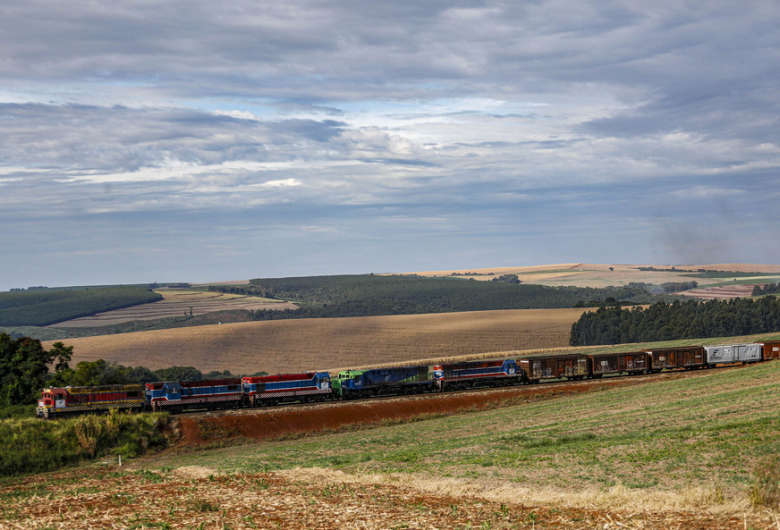RIO DE JANEIRO, BRAZIL – The government of the state of Paraná is getting ready to launch an extremely ambitious project: the Nova Ferroeste, a railroad system from Maracaju (MS) to the Paranaguá Port (PR), with an investment forecast of R$29.4 (US$5.6) billion. It is not yet clear if any investor is willing to disburse a check of this size.
The team expects to attract some foreign groups, even in an election year. In the financial market, however, there is little confidence that the plan will get off the drawing board at this point.
Read also: Check out our coverage on Brazil
Recently, feasibility studies were concluded, which indicated an internal rate of return of 11% and a payback period of 17 years within a 70-year contract.

Ferroeste is a state-owned company that operates a federal concession, from Cascavel (PR) to Guarapuava (PR). The stretch is already in operation but is restricted. The idea, now, is to expand the railroad, reform the current structure, and outsource everything to a private party.
The New Ferroeste would be 1,304 km long, from Maracaju to Paranaguá, with a branch line to Foz do Iguaçu (PR). The investment includes R$ 24.3 billion for construction, R$ 4.3 billion for rolling stock, and R$ 800 million in environmental compensation. There is also a plan for another branch line to Chapecó (SC), but it was not included in the recently finalized study.
However, there are still uncertainties, which go beyond attracting an investor. There are at least two uncertainties. The first is the legal modeling, which has not been finalized. In principle, the idea is to carry out the undertaking under an authorization regime, says the coordinator of GT Ferrovias, Luiz Henrique Fagundes.
Ferroeste has already requested the federal government to build the other stretches (outside the concession) through authorization – a new regime in which the responsibility is totally on the entrepreneur, without sharing risks or financial contribution from the government.
The federal government delegated the operation to Ferroeste. However, the arrangement is complex. There are doubts about how the state-owned company would bid for the whole corridor since part would be done as authorization and another part is already a concession in effect.
“I don’t know to what extent we will be able to get away from the concession. One possibility is to sell the concession. According to the laws being considered in Congress, we could transform everything into an authorization.”
Another issue is that there is still no definitive federal law that allows the authorization model, although a Provisional Measure (MP) is in force. In parallel, there is also a bill running on the subject.
When contacted, the Ministry of Infrastructure said that authorizations granted during the effectiveness of the MP are perfect legal acts and, if the project is approved, there will be legal security.
Ferroeste works with the scenario that by the end of 2021, before the public consultation, the final rule will be approved. In any case, says Fagundes, there is a plan B: to carry out the whole project as a sub-concession.
The second factor still pending is the environmental licensing. Ferroeste has been trying to accelerate the process – the studies have already been concluded. They will be sent to Ibama (Brazilian Institute of the Environment and Renewable Natural Resources) in the next few days. The government wants to have the preliminary license before the auction to give more security.
There are doubts about the viability of the project in the market, primarily via authorization – without resources or public support. One source observes that building a large railroad is difficult even with public money, let alone without.
Another person, who also requested anonymity, believes that authorization tends to work better when the investor is the owner of the cargo or one of the operators already consolidated in the country – which, in this case, would not be interested.
It is a good project for Bernardo Figueiredo, former director-general of ANTT (National Agency for Terrestrial Transport) and former president of EPL (Planning and Logistics Company). However, that will hardly get off the ground without public support. “It is a necessary connection, which makes the most economic sense.”
“My doubt is whether it stands up as a purely private investment.” He notes that in addition to funding, there is a considerable execution challenge in getting down the mountainside to the port. “It’s a heavy, risky investment. It would need some public participation.”
Asked about the difficulty of attracting investors under these conditions, Fagundes says he has had positive feedback so far. “Investors go for what is good; the market knows how to identify opportunities.”
In some cultures, the concession issue is a trauma because it involves reversible assets [returned to the public authority at the end of the contract]. The Americans and the Chinese don’t understand this. The authorization gives excellent comfort.
The plan is that the New Ferroeste will start to be built down the mountain, all the way to the port of Paranaguá, so that revenue can be generated – in the first year of operation, the projected movement is 38 million tons.
With the railroad now mature, the perspective is that capacity will reach 85 million tons per year. The main cargoes would be soy and corn, followed by soy meal and animal protein.
With information from Valor

